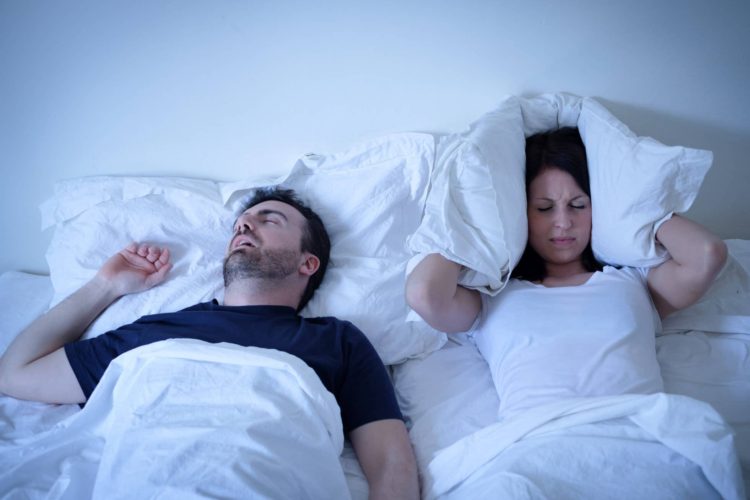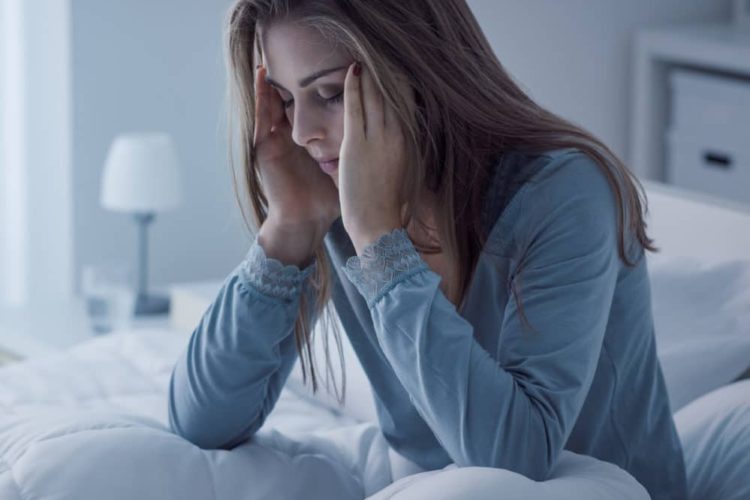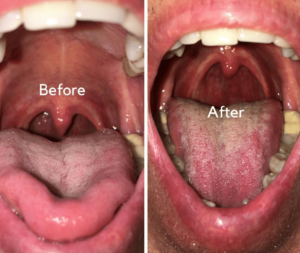Sleep Dentistry/Sleep Apnea (SBD, OSA)
50% of the population struggles with Sleep breathing disorders. Of those 20% have Obstructive Sleep Apnea while 40% of us snore. These are all examples of airway compromise. Dr. Garza has extensive training in Physiologic OSA and our care is saving lives! We screen every patient and issue a home sleep test for our patients when indicated.
What Is Sleep Apnea (Sleep Dentistry)?
According to Sleep Association, a dentist who specializes in treating sleep apnea with oral appliances, and other dental devices is called a sleep dentist. This type of dentist is also sometimes referred to as a sleep specialist.
In most cases, a sleep apnea dentist collaborates with other medical professionals to identify and treat patients who suffer from the condition. A bite impression is typically taken by the sleep dentist using a dental tray that is designed to fit inside the mouth. The patient is instructed to bite down into the putty, which then creates an impression of their teeth. After that, the imprint kit is delivered to a dental laboratory in order to have the sleep apnea oral device fabricated there.
After that, the sleep dentistry professional will evaluate the dental gadget’s position and how well it fits. In many cases, the patient will do the sleep study again while using the oral appliance to establish its effectiveness.
What Is The Difference Between Snoring And Sleep Apnea?

While snoring and sleep apnea share risk factors and similarities, the causes of snoring and their distinctions necessitate independent treatments.
Snoring
Snoring happens when the tissues and muscles in the throat relax, which allows air to pass through them. The relaxation causes the uvula to drop, which in turn causes vibration, resulting in the annoying sound known as snoring.
Snoring may be a temporary condition or the result of an underlying problem. Snoring can be brought on by a variety of factors, including frequent colds, abuse of alcohol, changes in weight, and advancing age. It is also possible to indicate more significant health problems, such as sleep apnea.
Sleep Apnea
Sleep apnea is a disorder in which you repeatedly stop breathing while sleeping, can have major repercussions on your health. Snoring, on the other hand, is often not a cause for concern, with the obvious exception of disrupting the sleep of people around you who are also attempting to get some rest.
It is estimated that over 25 % and roughly 10 percent of women suffer from sleep apnea. A person can develop sleep apnea at any age, including infants and children, but it is most common in people over the age of 50 and in overweight people.
Patients who suffer from obstructive sleep apnea tend to share several physical and clinical characteristics. These include having a wide neck, being overweight, and having structural abnormalities that reduce the diameter of the upper airway. Some of these structural abnormalities include having a nasal blockage, a low-hanging soft palate, swollen tonsils, or a tiny jaw with an overbite.
Even while snoring and sleep apnea are frequently linked to one another, it is not always possible to tell from a simple examination whether or not a person snore has sleep apnea. It is important to acquire a definitive response to this question because the effects of sleep apnea on one’s health can be extremely detrimental.
Snoring, hypopnea, upper airway resistance syndrome, central sleep apnea, and obstructive sleep apnea are all examples of sleep-related breathing disorders. Other sleep-related breathing disorders include obstructive sleep apnea and central sleep apnea (OSA). In the United States, obstructive sleep apnea (OSA) is the most common kind of sleep apnea, accounting for more than 80 percent of instances of sleep-disordered breathing.
What is Obstructive sleep apnea syndrome (OSA)?
Obstructive sleep apnea syndrome (OSA) is defined by recurrent restriction or collapse of the upper airway while the patient is asleep. This results in a partial or complete cessation of airflow despite the patient’s ongoing breathing attempts.
The presence of oral or craniofacial abnormalities (such as a wide tongue or tonsils, retrognathia), anthropometric traits (such as obesity), male gender, advanced age, and advanced age are all risk factors related to obstructive sleep apnea (OSA). Obstructive sleep apnea is associated with a wide variety of adverse health effects, including but not limited to sleep disruption and excessive daytime drowsiness, chronic hypertension, coronary heart failure, neurocognitive dysfunction, and ischemic stroke.
When untreated, obstructive sleep apnea (OSA), a prevalent kind of sleep disorder, can pose serious health risks. Even though obstructive sleep apnea is frequently misdiagnosed, its risk factors and symptoms that may indicate its presence can be discovered in a variety of clinical settings, including a dental office.
The most important indicator is how you feel during the course of the day. Snoring that is considered normal does not disrupt the quality of your sleep to the same extent as sleep apnea does, which means that you are less likely to experience extreme weariness and daytime sleepiness as a result. The manner that you sound when you snore can also provide useful information. Sleep apnea might be considered a possibility if, among other symptoms, you choke easily or make other noises that are out of the ordinary.
It is important to remember that even if you do not suffer from sleep apnea, a snoring problem can disrupt the rest of your bed companion and the quality of your sleep. However, there are a variety of remedies and techniques that might assist you in putting an end to your snoring.
How To Stop Snoring
If you are not sleeping with your bed partner due to snoring and/or sleep divorce. We have the answer! It’s called Nightlase or Snorelase. The Fotona Laser can tighten up that flappy throat area. Our patients have a 50% reduction after the first 10 minute Laser treatment. No, it doesn’t cut and doesn’t require anesthesia. The Laser simply warms the soft palate causing the collagen to tighten. The result is an enlargement of the airway within the oropharynx. The second and third treatments are performed in 2-week intervals and the snoring reduction is another 30% each visit. If you are not getting restful sleep and snoring is interfering with your life, Call our office today!
Types Of Sleep Apnea
There are three common types of sleep apnea:
- Obstructive Sleep Apnea: Obstructive Sleep Apnea occurs when the airway is blocked by relaxed muscle tissue
- Central Sleep Apnea: Central Sleep Apnea occurs when the brain “forgets” to direct muscles to breathe
- Complex Sleep Apnea: Complex Sleep Apnea is a combination of obstructive and central sleep apnea
What Causes Sleep Apnea?
Certain factors may play a role in causing sleep apnea, including obesity, cardiovascular problems and smoking. If you have enlarged tonsils or throat and tongue muscles that are more relaxed, this could also cause some level of sleep apnea.
Sleep Apnea Symptoms
Individuals with sleep apnea may experience one or more of the following symptoms:
- Excessive daytime sleepiness
- Loud snoring
- Insomnia
- Abrupt awakenings while sleeping
- Inconsistent breathing during sleep
- Gasping, choking, or coughing during sleep
- Hypertension
- Depression
- Obesity
- Lethargic feelings
- Morning headaches
- Mouth breathing
Respiration may cease for several seconds at a time and may occur hundreds of times a night.

How Does Dr. Garza Diagnose Sleep Apnea?
A thorough sleep study is the only method that can be used to establish a diagnosis of sleep apnea. These examinations are designed to assess your body while you are sleeping by keeping track of your breathing, blood oxygen levels, and other aspects of your brain activity.
Dr. Garza provides home sleep testing to assess sleep. The home testing device may monitor your heart rate, blood oxygen level, airflow, and breathing patterns while you sleep. The results of a home sleep test assist us to understand how to treat your sleep apnea effectively.
There has been a recent uptick in the number of dental practices offering sleep apnea and snoring treatment. Dentists who are interested in treating obstructive sleep apnea can receive support and instruction from the American Academy of Dental Sleep Medicine (AADSM). Your best bet is to look for a dentist who specializes in treating obstructive sleep apnea with dental appliance therapy.
They will collaborate with both you and your physician to determine the most appropriate course of treatment for you.
Talk to a dentist who is a member of the AADSM today if you have problems tolerating the continuous positive airway pressure (CPAP) therapy or if you would rather have an alternative treatment for your sleep apnea. Your snoring can be alleviated and the quality of your sleep enhanced with the assistance of a specialized dental device that can be fabricated just for you by an experienced dentist. Oral appliance treatment, often known as OAT, is something that can assist improve both your health and the overall quality of your life. Watch the video that has been provided for further information regarding OAT.
If Dr. Garza has determined that you suffer from obstructive sleep apnea (OSA), you will be given various treatment choices. A continuous positive airway pressure (CPAP) machine is typically considered the treatment of choice for obstructive sleep apnea (OSA). It’s possible that you won’t respond well to CPAP therapy for a variety of reasons. Oral appliance therapy is another alternative, and it involves the use of a device that is analogous to the mouth guards worn by athletes.
Sleep Apnea Treatment
We are pleased to offer non-surgical and non-invasive options that lessen sleep apnea episodes. Dr. John Garza is partnered with Medibyte and Breabon to provide accurate test results for your diagnosis. The results are read by a board certified sleep physician and Dr. Garza who will then prescribe a treatment plan. OSA is serious and life threatening. Contact our office today to learn how we can help.
What Is The MicrO2 Appliance?
MicrO2 sleep apnea therapy is a form of mandible advancement that facilitates air flow while you sleep. The FDA-approved oral appliance is made using CAD/CAM technology to ensure optimal fit over the upper and lower arches. The way that mandible advancement works is by precisely shifting the lower jaw forward. By doing this, the airway widens and remains in a supported open position. There are several mandible advancement devices available today. Dr. Garza prefers the MicrO2 appliance because it supports the physiologic position of the teeth, joints and muscles for ultimate comfort. Since 4 out of 5 patients are CPAP intolerant, The Micro2 is the best choice and easy to travel with.
Benefits Of The Micro2 Appliance
MicrO2 is appealing because:
- It is easy to use
- The device can be adjusted for comfort and effective airway opening
- CAD/CAM manufacturing achieves a precision fit
- The low profile of the device makes it comfortable
- Contoured edges prevent irritation to the lips and cheeks
- Two-part device enables free jaw movement
What Is CPAP?
CPAP stands for continual positive airway pressure. This medical therapy involves oxygen delivery directly into the nasal passageways via a small nose piece or mask. The air is sent from a machine that sits next to the bed. Air continuously travels through a hose and the mask at a rate of pressure that keeps the airway open.
Benefits Of CPAP Treatment
The primary benefit of CPAP treatment is that this therapy can prevent apnea episodes related to obstructive sleep apnea. However, many patients seek out alternatives to CPAP due to intolerance or unpleasant side effects.
What Is Snorelase?
Snorelase is a program that incorporates lifestyle suggestions alongside in-office laser treatments using NightLase® therapy. The patient-friendly laser treatment usually takes less than 30 minutes. It is painless and can begin to decrease sleep apnea symptoms after the very first session. Laser sleep apnea treatment works by strengthening the tissues of the soft palate through collagen production. When the tissue of the soft palate absorbs laser energy, fibroblast cells increase their production of collagen protein. Tissue contraction begins immediately. Strengthening occurs progressively and improves over the course of approximately 3 treatments.
Benefits Of Snorelase
 Patients appreciate several aspects of Snorelase, including:
Patients appreciate several aspects of Snorelase, including:
- No surgery, incisions, or anesthesia
- Comfortable treatments
- No downtime
- Measurable results are tracked using a simple app
- Improvement may occur after the first treatment
Risk Factors Of Untreated Sleep Apnea
Sleep apnea is a serious condition that requires intervention in order to prevent severe outcomes. Without adequate air flow during sleep, a person may suffer a number of worsening consequences. Severe daytime sleepiness from a lack of sleep could result in an increased risk of accidents as well as uncontrollable mood swings. Sleep apnea also increases the risk for heart conditions such as heart attack, stroke and insulin resistance.
Schedule a Consultation
If you are experiencing any of the symptoms associated with obstructive sleep apnea, it is important to schedule a consultation with Dr. Garza. OSA can be a serious health condition and should not be ignored. Treatment for obstructive sleep apnea typically includes lifestyle changes and/or the use of a CPAP machine. By taking proactive steps to address your breathing problems, you can improve your sleep quality and overall health.

